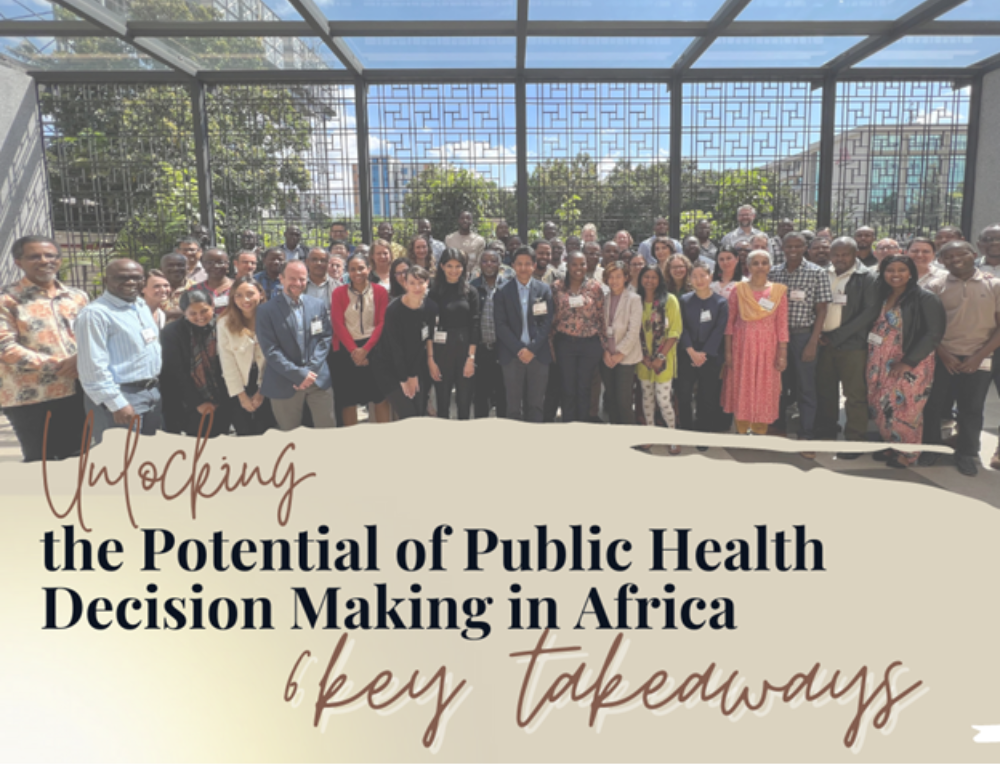Combating a Global Public Health Threat: Antimicrobial Resistance – What are we doing?


HITAP was invited to attend the “Strengthening Health and Disease Modelling for Public Health Decision Making” organised by the Bill and Melinda Gates Foundation (BMGF) and Wellcome on June 7–8, 2023 in Kigali, Rwanda. It brought together 110 virtual and on-site attendees, with 76 on-site modellers, policymakers, and relevant stakeholders from 27 countries across the globe, mainly from Africa. In this article, we share six key takeaways, from our perspective, from the sessions on possible solutions to strengthen public health modelling decision making in Africa.
This blog was written by HITAP. The interpretations and conclusions expressed in this blog do not necessarily reflect the views of the organising or participating agencies.
1. Empowering Local Partnerships for strengthening modelling for health decision making
If public health modelling is led locally and co-created with decision-makers, it can become an impactful tool for informing policy. However, concerns were raised about the varying capacities for modelling in low- and middle-income countries (LMICs). The COVID-19 pandemic has highlighted the need for capacity enhancement in national contexts, as a one-size-fits-all approach is not applicable. Moreover, local knowledge and expertise were significant in achieving genuine comprehension of the models and their results, and fostering fruitful collaboration. It is also crucial to translate tools and knowledge into non-English languages to ensure effective communication and accessibility. Furthermore, high-income countries (HICs) or funders should not dominate the network. Ownership should be emphasised, and the network’s governance should be determined by the network itself. It was suggested that the governance structure should include the rotation of the secretariat to involve all members, create equity and co-ownership.
2. Strengthening Networks, Centres of Excellence and Embedded Units
Building a trust-based relationship among countries would strengthen connections and collaboration in the region. This would enable knowledge exchange and the co-creation of solutions. Strengthening the network would allow countries to use models for policy support and compare progress across countries, potentially mitigating the impact of the pandemic to some extent.
Furthermore, one can leverage the network and collaborate with partners to acquire additional data, enriching resources when faced with limited data availability. While Centers of Excellence (CoEs), which are defined as independent academic or research institutions with modelling expertise, and Modelling Units in National Public Health Institutes (NPHIs) or Ministries of Health (MoH), which are defined as modelling units within government systems, are both valuable, they are not the only options to consider. Their interconnectedness may vary, and there is no one-size-fits-all solution as it depends on the context in different settings. Moreover, it is necessary to develop a framework or platform that enhances an expert community, promotes equity, and ensures that everyone’s voice is heard.
It is critical to demonstrate the value of such a network or platform, identify gaps in the stakeholder ecosystem, and create clear goals and Terms of Reference (ToR). A resource mobilisation strategy is also required, as well as capacity development on topics such as tackling gender inequities and building career pathways for modellers. Maintaining connections with stakeholders is also essential to long-term success. In terms of measuring the success of these efforts, one way is to assess the use of the model and its impact.
3. Enhancing capacity building for use of modelling for health decision-making

During the session, it was discussed that capacity building is crucial, not only for modellers, but also for government officials and policymakers. This could result in a greater understanding and garner robust support among decision-makers and policymakers for enhancing data infrastructure, leading to improved decision making in public health. Currently, there is a lack of staff performing modelling and also involved in its usage; thus, training the next generation and supporting early career researchers must also be considered. Moreover, mentorship and the need to understand the current capacity of countries are also important. Nurturing champions, who will lead such efforts to use modelling for decision-making in their own contexts, is an important ingredient in the long-term success of capacity building efforts.
4. Ensuring Sustainability of Modelling Endeavours
One crucial aspect to consider is the sustainability of these efforts, which hinges on two key factors: funding and human resources. While capacity building and training are essential (as mentioned above), it is critical to maintain financial support to accelerate the development of modelling capabilities and policy. However, sustaining these efforts should not solely rely on external funders but may also consider public funding or the private sector. For example, when part of a network, it is important to encourage members to take ownership of their funding responsibilities, as highlighted by Sarin KC from HITAP, when sharing experiences from the HTAsiaLink network, which comprises Health Technology Assessment (HTA) agencies in Asia.
5. Tackling data challenges for modelling
Various challenges were identified during the discussion on cross-cutting issues, one of which related to data. The main issues namely limited data sharing, lack of data-relevance, inadequate quality and completeness of data, restricted data access, and difficulties in translating models into a common language for policymakers and decision-makers. However, Saudamini Dabak from HITAP highlighted that data sharing practices could depend on different settings and the paradigms in which they operate. For example, Thailand has implemented the Personal Data Protection Act (PDPA), a national law governing data protection in the digital age that poses challenges to data access as well as data sharing practices. In addition, to promote data accessibility, it is crucial to engage with the private sector to make data available. This effort requires understanding among different stakeholders and trust in the relationship. Moreover, increasing data ownership can be achieved by involving the data owners themselves in the process. There are also increasing efforts to link data generation with modelling efforts and there is potential for greater linkages between clinical trials and research, including modelling.
6. Promoting transparency in health decision-making
Transparency plays an important role in generating models as it promotes trust among policymakers, modellers and the community. To achieve this, it is essential to make data accessible, for instance, provide documentation of the codes used in the models. Potential users, researchers, policymakers, and citizens can gain a greater understanding of how codes are used. Simplifying complex information, such as creating policy briefs, can support effective communication with the public.
Ensuring that people understand the model could enable its reproduction and build trust within the community. Establishing accountability to the public, including giving a clear explanation from the beginning, for example, of the assumptions and limitations of models, needs to be considered. Trust and strong relationships were key factors in maintaining and strengthening the continued use of these models.
—————
Our Current Effort: Lancet Commission on Strengthening the Usefulness of Epidemiological Modelling
Currently, HITAP is the co-Secretariat of the Lancet Commission for Strengthening the Use of Epidemiological Modelling of Emerging and Pandemic Infectious Diseases, together with the Saw Swee Hock School of Public Health, National University of Singapore (SSHSPH NUS). This initiative seeks to enhance the usefulness and impact of epidemiological modelling on policymaking and policy implementation by examining and has brought together experts from various disciplines across the world to address several gaps in the field. The expected outputs from the Commission include recommendations for governance for use of modelling for making decisions on health policy, tools for translating policy questions into research questions for modellers, standards for communicating model results and decisions, among others.
The Commission is supported by the Access and Delivery Partnership (ADP), hosted by the United Nations Development Programme (UNDP).
More information on the Commission can be found here: https://www.hitap.net/en/research/186684